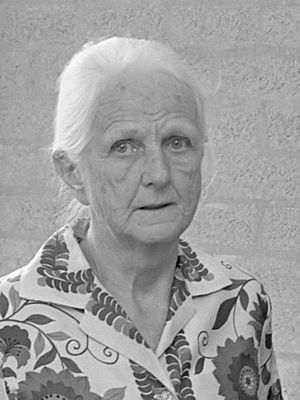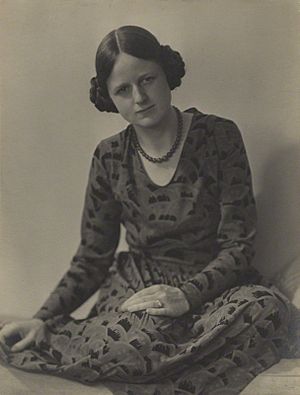Joan Robinson facts for kids
Quick facts for kids
Joan Robinson
|
|
|---|---|

Robinson in 1973
|
|
| Born |
Joan Violet Maurice
31 October 1903 Surrey, England
|
| Died | 5 August 1983 (aged 79) Cambridge, England
|
| Field | Monetary economics |
| School or tradition |
Post-Keynesian economics |
| Influences | Adam Smith, Karl Marx, John Maynard Keynes, Piero Sraffa, Michał Kalecki |
| Contributions | Joan Robinson's growth model Amoroso–Robinson relation Monopsony theory |
Joan Violet Robinson (born October 31, 1903 – died August 5, 1983) was a very important British economist. She made many big contributions to how we understand economic theory. She was a key person in a group of economists known as post-Keynesian economics. This means she built on the ideas of another famous economist, John Maynard Keynes.
Contents
About Joan Robinson
Early Life and Education
Joan Maurice was born in 1903 in Surrey, England. Her father was Frederick Maurice and her mother was Margaret Helen Marsh.
She studied economics at Girton College in Cambridge. After graduating in 1925, she married another economist, Austin Robinson. They had two daughters.
In 1937, Joan Robinson became a teacher of economics at the University of Cambridge. She became a full professor in 1965. She was also chosen as a member of important academic groups, like the British Academy in 1958. In 1979, she became the first female honorary member of King's College.
Her Work During Wartime
During World War II, Robinson worked on different committees for the government. She also traveled to countries like the Soviet Union and China. These trips made her very interested in developing nations and how their economies grew.
She visited the Centre for Development Studies (CDS) in India many times. She even set up a fund there to support public talks about economics. She also gave the royalties from two of her books to the CDS.
Travels and Observations
Robinson made several trips to China. She wrote books about her observations, like China: An Economic Perspective (1958) and Economic Management in China (1975). She also visited North Korea in 1964. She wrote that North Korea's success came from its strong national pride.
Near the end of her life, she became more thoughtful about how economic theory could be improved.
Joan Robinson's Big Ideas
Joan Robinson introduced many important ideas in economics. She was part of "the Cambridge School" of economics. This group helped explain and support the ideas of John Maynard Keynes in his book, General Theory. She wrote especially about how his ideas affected employment during the Great Depression.
Understanding Competition
In 1933, Robinson wrote a book called The Economics of Imperfect Competition. In this book, she created the word "monopsony."
- A monopoly is when there is only one seller of a product or service.
- A monopsony is the opposite: it's when there is only one main buyer.
Monopsony is often used to describe situations where an employer is the main buyer of labor. This means the employer has a lot of power to set wages. Robinson used this idea to explain why there might be a wage gap between women and men workers, even if they did the same amount of work.
Recently, in 2019, the United States Supreme Court used Robinson's monopsony theory in a case called Apple v. Pepper. The court said that Apple could be sued by app developers based on this idea of monopsony.
Other Important Books
In 1942, Robinson wrote An Essay on Marxian Economics. This book focused on Karl Marx as an economist. It helped bring new discussions about his ideas.
Her most famous work, The Accumulation of Capital, was published in 1956. This book took Keynes's ideas and applied them to the long term growth of economies.
In 1962, she published Essays in the Theory of Economic Growth. This book talked about different ways economies could grow, including "Golden Age growth paths." She also worked with Nicholas Kaldor to develop the Cambridge growth theory.
Between 1962 and 1980, she wrote many economics books for the general public. She wanted to create new ways of thinking about economics.
Achievements and Influence
Joan Robinson achieved many important things in her career:
- In 1945, she was the only economist and only woman on the Ministry of Works' Advisory Committee on Building Research.
- In 1948, she became the first economist to be part of the Monopolies and Mergers Commission.
- She was a major participant in the Cambridge capital controversy during the 1960s. This was a big debate about how capital (money and assets used to produce goods) is measured in economic models.
Influencing Future Economists
Many students who studied with Joan Robinson went on to become very successful economists. At least two of her students won the Sveriges Riksbank Prize in Economic Sciences in Memory of Alfred Nobel: Amartya Sen and Joseph Stiglitz.
Joseph Stiglitz described their relationship as "tumultuous," meaning it was sometimes difficult. He said Robinson was not used to students asking many questions. Amartya Sen called her "totally brilliant but vigorously intolerant."
She also influenced Indian Prime Minister Manmohan Singh, which changed his approach to economic policies.
Recognition
In 2016, the University of Cambridge decided to name a physical feature in the North West Cambridge Development after Joan Robinson. This shows how much her contributions are valued.
Major Works
- The Economics of Imperfect Competition (1933)
- Essays in the Theory of Employment (1937)
- An Essay on Marxian Economics (1942)
- Accumulation of Capital (1956)
- Exercises in Economic Analysis (1960)
- Essays in the Theory of Economic Growth (1962)
- Economic Philosophy: An Essay on the Progress of Economic Thought (1962)
- Freedom and Necessity: An Introduction to the Study of Society (1970)
- Economic Heresies: Some Old Fashioned Questions in Economic Theory (1971)
- Contributions to Modern Economics (1978)
Books for Everyone
Joan Robinson also wrote books to help regular people understand economics:
- Economics is a serious subject (1932)
- Introduction to the Theory of Employment (1937)
- The Cultural Revolution in China (1969)
- An Introduction to Modern Economics (1973) with John Eatwell
- The Arms Race (1981)
See also
 In Spanish: Joan Robinson para niños
In Spanish: Joan Robinson para niños


